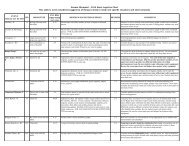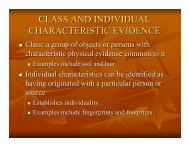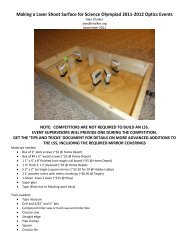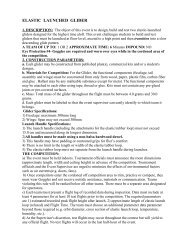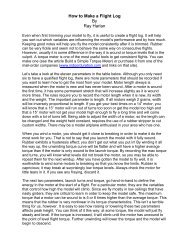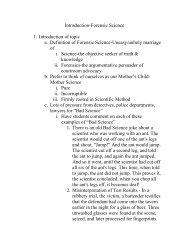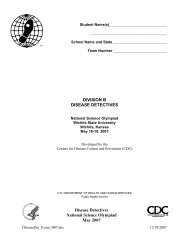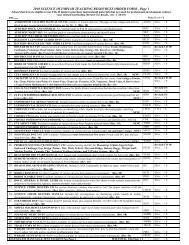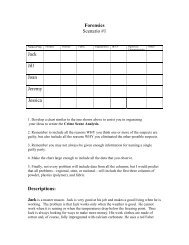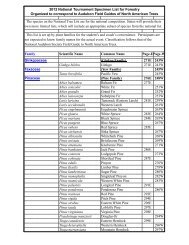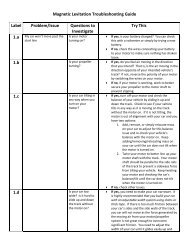Individual Solid Nonmetal analysis Many chemicals come in the ...
Individual Solid Nonmetal analysis Many chemicals come in the ...
Individual Solid Nonmetal analysis Many chemicals come in the ...
You also want an ePaper? Increase the reach of your titles
YUMPU automatically turns print PDFs into web optimized ePapers that Google loves.
<strong>Individual</strong> <strong>Solid</strong> <strong>Nonmetal</strong> <strong>analysis</strong><strong>Many</strong> <strong>chemicals</strong> <strong>come</strong> <strong>in</strong> <strong>the</strong> form of powders or crystals. At first quick glance, itmay look like <strong>the</strong>y all look ra<strong>the</strong>r similar. But a closer look will show you that <strong>the</strong>re aresome major differences right off. We are go<strong>in</strong>g to look at 13 different solid nonmetalsubstances. We will learn how to identify <strong>the</strong>m <strong>in</strong>dividually and <strong>the</strong>n we will look at howto identify some of <strong>the</strong>m when <strong>the</strong>y are mixed toge<strong>the</strong>r. As with <strong>the</strong> liquids and <strong>the</strong>metals, <strong>the</strong> identification will be on <strong>the</strong> basis of how <strong>the</strong> materials look, smell, <strong>the</strong>ir pHwhen mixed with water and if/how <strong>the</strong>y dissolve or react with water, acid and iod<strong>in</strong>e.The first th<strong>in</strong>g you need to observe is whe<strong>the</strong>r <strong>the</strong> solid is a powder, crystal, orgranule. This will be done by look<strong>in</strong>g at <strong>the</strong> substance with a magnify<strong>in</strong>g glass. As with<strong>the</strong> liquids and metals, <strong>the</strong> ID material will be given to you <strong>in</strong> both a table and decisionchart. You will be expected to record your own observations on <strong>the</strong> <strong>in</strong>dividual solidnonmetals. We will be us<strong>in</strong>g a wooden spl<strong>in</strong>t to take small amounts of <strong>the</strong> substances andputt<strong>in</strong>g <strong>in</strong> <strong>the</strong> wells of a "spot plate". While <strong>the</strong>y are <strong>in</strong> <strong>the</strong> spot plate, you can test <strong>the</strong>mfor how <strong>the</strong>y react with water, acid, iod<strong>in</strong>e, etc. But of course you will not want to addmore than one reagent to <strong>the</strong> solid at a time. Therefore you will need to keep clean<strong>in</strong>g <strong>the</strong>spot plate between each set of trials. You have a jar at your desk that you should use yourwash bottle to wash <strong>the</strong> residue <strong>in</strong> <strong>the</strong> spot plate after each set of tests <strong>in</strong>to.Substance Shape & Size pH Solubility <strong>in</strong> Reaction to Reaction to I 2 O<strong>the</strong>rwater HClObservationsAlka-Seltzer Powder ~6 Fizzes Fizzes Sta<strong>in</strong>s pale CrumblesyellowBak<strong>in</strong>g Soda Powder ~8 Soluble Fizzes Sta<strong>in</strong>s paleCalciumCarbonatePowder ~6 Insoluble seeendFizzesyellowSta<strong>in</strong>s paleyellowMay appear todissolve, butsettlesCornstarch Powder ~8 Soluble-smooth No Reaction Turns blueFlour Powder ~6 Soluble-lumpy No Reaction Turns blueGelat<strong>in</strong> Crystal ~6 Soluble-jellylikeNo reaction Sta<strong>in</strong>s paleyellowGypsum Powder ~6 Solublew/bubblesNo reaction Sta<strong>in</strong>s paleyellowSalt Uniform cubes ~7 Soluble No Reaction Sta<strong>in</strong>s paleyellowSand Irregular shape ~6 Insoluble No Reaction Sta<strong>in</strong>s paleyellowSodium Irregular ~8 Soluble No Reaction Sta<strong>in</strong>s paleAcetate ShapeyellowSugar Irregular Size ~7 Soluble No Reaction Sta<strong>in</strong>s paleyellowVitam<strong>in</strong> C Irregular Size ~2 Soluble No Reaction Turns I 2 clear Crumbles-YellowishYeast Granular ~7 Soluble butdelayNo Reaction Sta<strong>in</strong>s paleyellowPale YellowishcastWill not crumbleCrystals almostclearTarnish cloudywater
Or ano<strong>the</strong>r way to look at <strong>the</strong> problem is with a decision chart. For nonmetal solids <strong>the</strong>chart would look like this:YesFizz <strong>in</strong> YesAlka-SeltzerPowder?H 2 O?NoNoYesSoluble Yes Bak<strong>in</strong>gCrystall<strong>in</strong>e?ReactSoda<strong>in</strong> H 2 Ow/HClNoNoCalcium CarbonateYesNoYeastSoluble<strong>in</strong> H 2 O?Turn Bluew/I 2 ?YesYesNoJelly-like?PH~8YesYesNoCornstarchFlourGypsumGelat<strong>in</strong>SandNoNoPH~8YesSodium AcetateNoTurns I 2 Clear? Yes Vitam<strong>in</strong> CNoRegularSaltNoSugar



